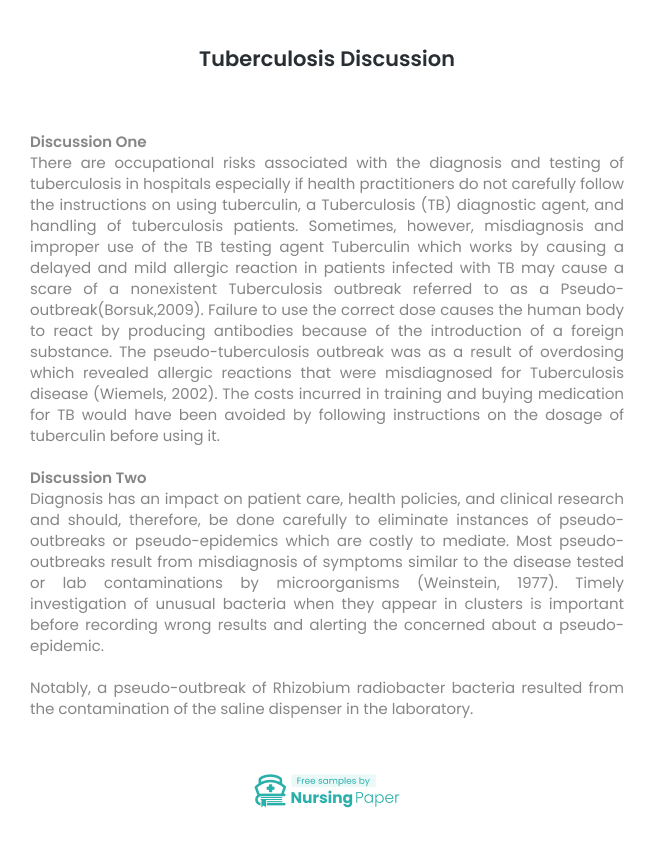
Tuberculosis Discussion
Discussion One
There are occupational risks associated with the diagnosis and testing of tuberculosis in hospitals especially if health practitioners do not carefully follow the instructions on using tuberculin, a Tuberculosis (TB) diagnostic agent, and handling of tuberculosis patients. Sometimes, however, misdiagnosis and improper use of the TB testing agent Tuberculin which works by causing a delayed and mild allergic reaction in patients infected with TB may cause a scare of a nonexistent Tuberculosis outbreak referred to as a Pseudo-outbreak(Borsuk,2009). Failure to use the correct dose causes the human body to react by producing antibodies because of the introduction of a foreign substance. The pseudo-tuberculosis outbreak was as a result of overdosing which revealed allergic reactions that were misdiagnosed for Tuberculosis disease (Wiemels, 2002). The costs incurred in training and buying medication for TB would have been avoided by following instructions on the dosage of tuberculin before using it.
Discussion Two
Diagnosis has an impact on patient care, health policies, and clinical research and should, therefore, be done carefully to eliminate instances of pseudo-outbreaks or pseudo-epidemics which are costly to mediate. Most pseudo-outbreaks result from misdiagnosis of symptoms similar to the disease tested or lab contaminations by microorganisms (Weinstein, 1977). Timely investigation of unusual bacteria when they appear in clusters is important before recording wrong results and alerting the concerned about a pseudo-epidemic.


Notably, a pseudo-outbreak of Rhizobium radiobacter bacteria resulted from the contamination of the saline dispenser in the laboratory. Clinical specimen isolates had the same antimicrobial susceptibilities and electrophoretic fingerprints as those of Rhizobium bacteria leading to recording of wrong results (Pereira 2009). An artificial clustering of real infections was corrected by autoclaving the dispenser.
Discussion Three
Vaccination has managed to reduce and even eliminate infectious diseases. Vaccines work by imitating an infection hence resulting in immunogenicity. Different vaccines cause different immune responses. For instance, in HPV, measles, and chickenpox, vaccination results in the permanent resistance to diseases. Measles virus does not promote type 1 interferons but leads to the production of chemokines and cytokines. The rash symbolizes the production of cell adaptative immune response which infiltrates into replication sites of the measles virus, clearing the RNA of the disease (Griffin, 2016). However, RNA clearance occurs after weeks and months after disease resolution leading to immunosuppression. Measles virus specific antibody matures from type 1 to type 2 promoting 17 cell responses that result in B-cell development and long-term protection because of sustained neutralization of the antibody. In STDs however, the disease has diverse heterogeneity revealing different immunogenetic responses depending on disease type.
Wanted immunogenicity is the use of vaccines to imitate an infection so that the body produces antibodies to guarantee resistance to a disease. Wanted immunogenicity is helpful in preventing infectious diseases. Unwanted immunogenicity is when biological therapeutics induce an immune response because of allergic reactions, hypersensitivity or diminution(Pereira, 2009).

1. Borsuk, S., Newcombe, J., Mendum, T. A., Dellagostin, O. A., & McFadden, J. (2009). Identification of proteins from tuberculin purified protein derivative (PPD) by LC-MS/MS. Tuberculosis, 89(6), 423-430.
2. Griffin, D. E. (2016). The Immune Response in Measles: Virus Control, Clearance and Protective Immunity. Viruses, 8(10), 282.
3. Pereira, L. A., Chan, D. S. G., Ng, T. M., Lin, R., Jureen, R., Fisher, D. A., & Tambyah, P. A. (2009). Pseudo-outbreak of Rhizobium radiobacter infection resulting from laboratory contamination of saline solution. Journal of clinical microbiology, 47(7), 2256-2259.
4. Wadhwa, M., & Thorpe, R. (2007). Unwanted immunogenicity: Implications for follow-on biologicals. Drug information journal, 41(1), 1-9.
5. Weinstein, R., & Stamm, W. (1977). Pseudoepidemics in hospital. The Lancet, 310(8043), 862-864.
6. Wiemels, J. L., Wiencke, J. K., Sison, J. D., Miike, R., McMillan, A., & Wrensch, M. (2002). History of allergies among adults with glioma and controls. International journal of cancer, 98(4), 609-615.



The download will start shortly.

The download will start shortly.
 Subject:
Nursing
Subject:
Nursing  Number of pages: 2
Number of pages: 2  Subject:
Nursing
Subject:
Nursing  Number of pages: 4
Number of pages: 4  Subject:
Health and Social Care
Subject:
Health and Social Care  Number of pages: 4
Number of pages: 4  Subject:
Health and Social Care
Subject:
Health and Social Care  Number of pages: 5
Number of pages: 5  Subject:
Health and Social Care
Subject:
Health and Social Care  Number of pages: 2
Number of pages: 2  Subject:
Nursing
Subject:
Nursing  Number of pages: 2
Number of pages: 2  Subject:
Health and Social Care
Subject:
Health and Social Care  Number of pages: 9
Number of pages: 9  Subject:
Nursing
Subject:
Nursing  Number of pages: 2
Number of pages: 2  Subject:
Health and Social Care
Subject:
Health and Social Care  Number of pages: 3
Number of pages: 3  Subject:
Medicine
Subject:
Medicine  Number of pages: 6
Number of pages: 6  Subject:
Nursing
Subject:
Nursing  Number of pages: 6
Number of pages: 6  Subject:
Nursing
Subject:
Nursing  Number of pages: 3
Number of pages: 3  Subject:
Nursing
Subject:
Nursing  Number of pages: 8
Number of pages: 8  Subject:
Nursing
Subject:
Nursing  Number of pages: 2
Number of pages: 2  Subject:
Health and Social Care
Subject:
Health and Social Care  Number of pages: 10
Number of pages: 10 
